China’s 1st Moon rover ‘Yutu’ embarks on thrilling adventure marking humanity’s first lunar surface visit in nearly four decades. Yutu portrait taken by the Chang’e-3 lander. Credit: CNSA/CCTV
See below Yutu’s departing portrait of Chang’e-3 lander emblazoned with Chinese national flag
Story updated[/caption]
China’s now famous ‘Yutu’ moon rover has set sail for what promises to be breathtaking new adventures on Earth’s nearest neighbor, after completing a final joint portrait session with the Chang’e-3 lander that safely deposited her on the lunar surface only a week ago.
Yutu’s upcoming journey marks humanity’s first lunar surface visit in nearly four decades since the Soviet Union’s Luna 24 sample return vehicle visited. America’s last lunar landing mission with the Apollo 17 astronauts departed 41 years ago on Dec. 14, 1972.
The Chang’e-3 mothership and Yutu rover have resumed full operations after awakening from a sort of self induced slumber following commands from Mission Control back in Beijing.
The lander and rover finished up their 5th and final dual picture taking session – in living lunar color – on Sunday, Dec. 22, according to CCTV, China’s state run broadcast network.
“Ten pictures have been taken at five spots so far, and all of them are better than we expected,” said Wu Weiren, chief designer of the China Lunar Probe Program, to CCTV.
See the newly released portraits from photo session 5 – above and below.
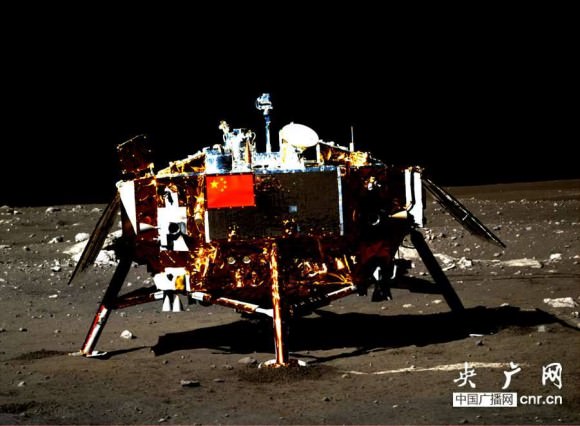
Credit: CNSA/CCTV
After arriving on the moon, Yutu and the lander took an initial pair of portraits of one another. Read my earlier report – here.
Yutu was then directed to travel in a semicircular path around the lander and to the south, making tracks several centimeters deep into the loose lunar regolith.
But within two days of the historic Dec. 14 touchdown, the two spacecraft took a four-day break that lasted from Dec. 16 to Dec. 20, during which China’s space engineers shut down their subsystems, according to China’s State Administration of Science, Technology and Industry for National Defense (SASTIND).
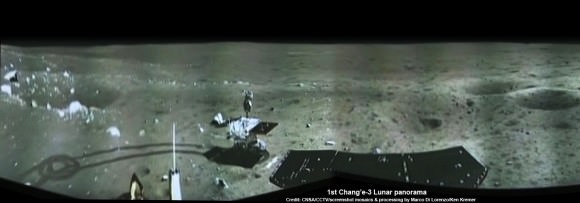
The vehicles took a ‘nap” to deal with direct solar radiation that significantly raised their temperatures. Yutu’s sunny side exceeded 100 degrees centigrade while the shaded side was simultaneously below zero, reported SASTIND.
“The break had been planned to last until Dec. 23, but the scientists decided to restart Yutu now for more research time, based on the recent observations and telemetry parameters,” said Pei Zhaoyu, spokesman for the Chinese lunar program, according to China’s Xinhua state news agency.
Both robots then snapped additional photos of one another during the traverse from each of five specific and preplanned locations.
See accompanying traverse map below – written in Chinese.
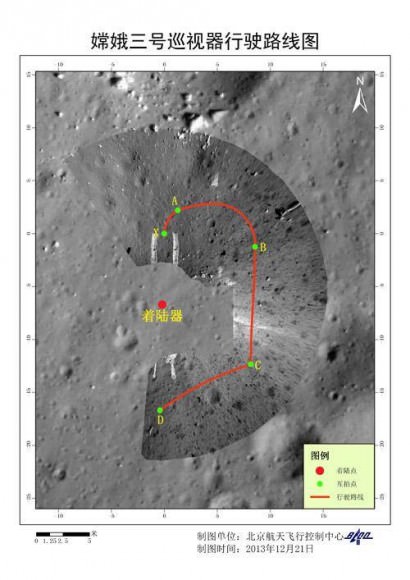
These images taken by Yutu were designed to show the 1200 kg Chang’e-3 lander from the front, side and back sides as it drove around the right side – for better illumination – at a distance of about 10 meters.
The final image of the Chang’e-3 lander taken by Yutu also captured China’s national flag emblazoned on the lander for the first time, since this was the first time it was in view of the rover’s camera eyes.
See the accompanying traverse graphic here – written in Chinese.
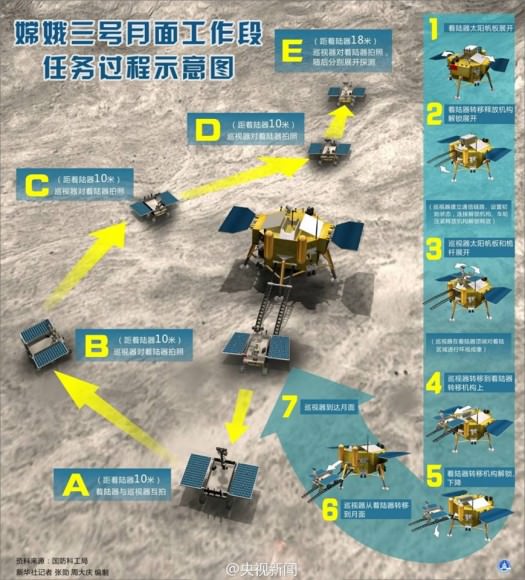
Having fulfilled the last of their joint tasks, the two spacecraft can therefore each begin their own lunar exploration missions, working independently of one another exactly as planned from the outset of China’s inaugural moon landing feat.
Yutu will depart the Chang’e-3 landing zone forever and begin its own lunar trek that’s expected to last at least 3 months – and perhaps longer if it’s delicate electronic components survive the moon’s utterly harsh and unforgiving space environment.
“They will begin to conduct scientific explorations of the geography and geomorphology of the landing spot and nearby areas, and materials like minerals and elements there. We will also explore areas 30 meters and 100 meters beneath the lunar soil. The exploration will continue longer than we planned, because all the instruments and equipments are working very well,” noted Wu Weiren.
The robotic pair of spacecraft safely soft landed on the Moon on Dec. 14 at Mare Imbrium, nearby the Bay of Rainbows, or Sinus Iridum region.
Barely seven hours after the history making touchdown, ‘Yutu’ was painstakingly lowered from its perch atop the lander and then successfully drove all six wheels onto the moon’s surface on Dec. 15.
The Chang’e-3 mothership captured a panoramic view of the stark lunar terrain surrounding the spacecraft after ‘Yutu’ drove some 9 meters away from the lander.
See the eerie panoramic view of the landing site showing Yutu’s first moments on the alien lunar surface in my prior story – here.
See the dramatic video with an astronauts eye view of the lunar descent and touchdown in my prior story – here.

The 120 kg Yutu rover is almost the size of a golf cart. It measures about 1.5 m x 1 m on its sides and stands about 1.5 m (nearly 5 feet) tall – virtually human height.
Yutu, which translates as ‘Jade Rabbit’ will use its suite of four science instruments to survey the moon’s geological structure and composition to locate the moon’s natural resources for use by potential future Chinese astronauts, perhaps a decade from now.
Stay tuned here for Ken’s continuing Chang’e-3, LADEE, MAVEN, MOM, Mars rover and more news.
Ken Kremer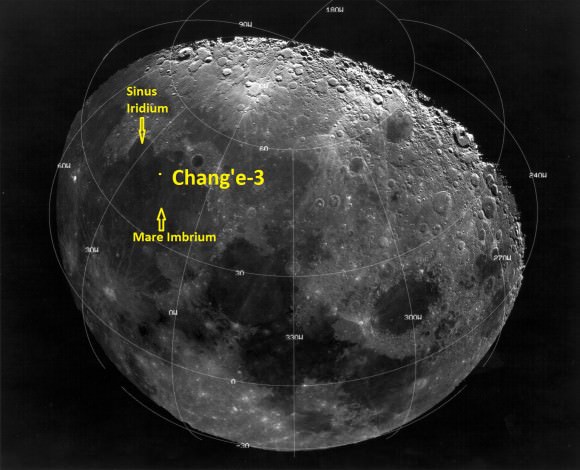 Landing site of Chinese lunar probe Chang’e-3 on Dec. 14, 2013. [/caption]
Landing site of Chinese lunar probe Chang’e-3 on Dec. 14, 2013. [/caption]

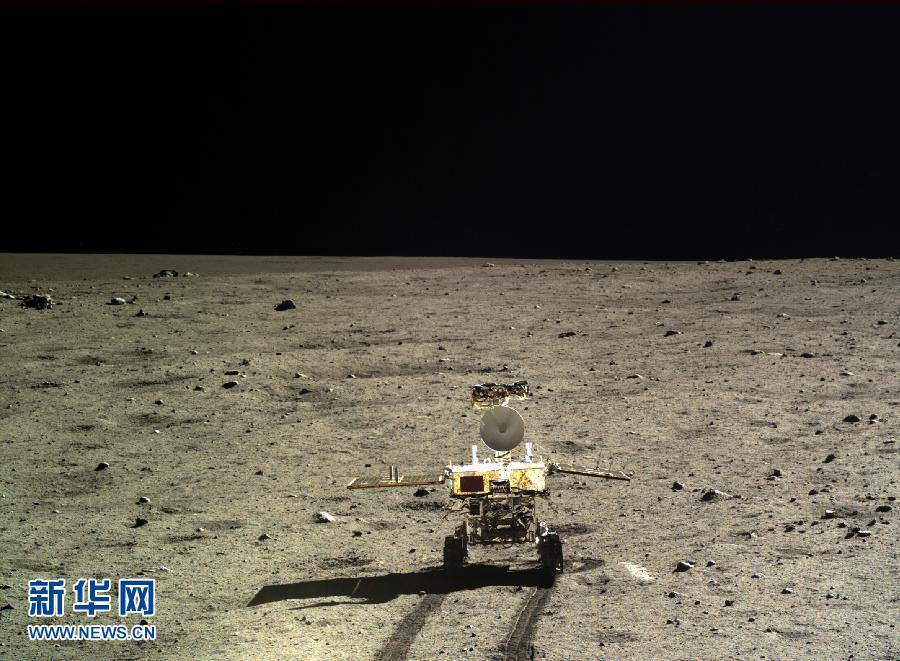
Yutu translates into English as Jade Rabbit!
The moon is still a fascinating place.
I have noticed the brownish surface. Not the expected Gray.
I am wondering if this is a camera artefact.
My camera also take images that are clearly brownish under certain light conditions.
Nice Mandarin cointelpro
Fantastic job well done China, its great to see Jade Rabbit traveling around the lander, and we wish you great success over the next 3 months (or more) your pictures sent back to Mother Earth are awesome so thank you for the magnificent job you are doing on the Moon……
When almost a new moon, I hope they snap a photo of the Earth, like the one our astronauts took.
Bon Voyage Jade Rabbit! Don’t forget to write and send pictures! We hope you find something that convinces the rest of us, including the USA, to return to the Moon!
lets hope that happens!
I want to see more pictures of the moon. This is really exciting. I am a little disappointed to see no trees or grass at all. I am hoping we can find some forms of lives upthere. It is really great to see all the moon pictures.
Trees and grass on the Moon?! Er… dude, I think you’ve had too much eggnog!
One article on this began with Stunning. Of course there was nothing of the sort. Article just as this one filled from end to end with graphical representations.
Now this one uses breath taking. Well where is the taking of breath? More like the letting down of billions to me. May I suggest the use of Heart Breaking?
“Set Sails for Heart Breaking let down after 11 days of 0000-ZERO-0000 updates, videos, images after day one”
Have you noticed how the ‘right hand’ solar panel on the rover is lower than the left? Am SURE that is intentional… or at least assume it so. But consider they landed at noon, doesn’t it seem that both panels would be flat toward Sol at that time?
notice that the shadows go off to the left, so the sun is up at an angle in the sky.
There are no trees or grass in the Moon. On the other hand, there’s cheese everywhere!
Notice the 1st, 2nd and 3rd picture from the top.
They all show the sky as “pitch black”… with no stars on it…..
On the Moon you have to light pollution therefore sky should be filled with Stars…
Notice 2nd picture, this landing rover as it landed with a rocket propelling gas downwards towards the Moons surface, it must have disturbed a lot of the Moon dust, and we know the Moon has lots of dust in its surface.
So how come there is no dust on top of the Landing Rovers feet? Surely the disturbed dust would have to come back down again and cover the feet? Why are those feet so sparkly?
3rd picture, is black and white!! do I need to say more? The first two are in colour but the third in black and white?
Come on people how naive can you be….!!!!! The chinese are surely using the same tricks as NASA did to convince the sheep that they have landed on the Moon.
Sarcasm over.
no stars are captured because starlight is very faint. for cameras to capture starlight, exposure times of several seconds are needed. since the lunar surface is comparatively very bright, images of the surface with exposure times of several seconds would be badly overexposed and washed out.
you’ll be happy to know, though, that the lander does contain a telescope that is meant to observe the stars.
the lander cut its engines a few feet above the surface, so when it landed there shouldn’t have been any dust blast to gather on the feet. remember, the moon has no atmosphere, so there are no billowing dust clouds, the dust that got kicked up just falls back down to the surface immediately.
the third picture appears to be in color. the quality is very low, however, since it is taken from a Chinese media video.
The best proof that NASA has been lying for the past 47 years. The moon is not black and white. is full in colors. The Moon is not just crater everywhere; is full of terrine brown sand, rocks and strange structures. Just doing close up to those pictures you can see some objects geometrical. Our brain is programmed to expect an isolate sand black and white where nothing exists Open up your mind and do some close up to those pictures and you will find the truth.
there are Apollo pictures which show the lunar soil as more brown in color. this is primarily due to the incident angle of the sunlight.
Thanks for the info Hug. I am 100% sure about NASA’s cover up. First, any landscape seen for miles away, colors dissipate becoming a fading white smokey. Mars looks brownish due to the reddish color of mos of the surface. Earth looks bluesh and white. The effect of getting a white color means much colors or all possible color present. This is basic science. Experts in photography agree on that. So the moon looks white from far away. That would mean all colors present. Very few people know what the moon really looks like. The best proof of my statement is to check your iPad or iPhone apps. While all planets can be seen in full color, only the moon, the closest one of all, is black and white.
the Moon is different – there is no atmosphere, so there is no haze. details don’t fade with distance, which is why a lot of conspiracy nuts think that the distant mountains in lunar landscape images are a backdrop. you are completely correct that haze does happen on the Earth and on Mars, though.
anyone who looks up at the night sky knows what the Moon looks like. get a telescope or find a friend who has one. you can look at the Moon for yourself.
while the Apollo surface excursions often showed us a pretty uniformly gray moon (with a number of notable exceptions, like orange soil!) http://history.nasa.gov/alsj/a16/AS16-117-18841HR.jpg the moon isn’t really black and white, there are lots of subtle colors thanks to the mineral content of different areas on the Moon, and how predominant iron or titanium are on the surface.
however, you can make the colors more apparent by using color filters http://www.thelivingmoon.com/43ancients/02files/Moon_Images_Galileo.html or you can modify a full-color picture of the Moon in photoshop by cranking up the color saturation, to make these subtle hues much more visible as well http://www.rc-astro.com/photo/id1018.html
sometimes the color stands out, sometimes not. much depends on the angle of the sunlight on the surface, you can pick out colors under some lighting conditions that are obscured by others. notice the difference between these two pictures: http://scotteallen.net/wp-content/uploads/2009/09/jw_moon_yankee_rcx_color.jpg
http://deepskycolors.com/pics/astro/2008/10/10-12-2008_MoonColor.jpg
Download first picture. Open up using Microsoft Picture Manager. Do a close up to 400 or 800. Take a look at the top left side and there is a geometrical structure as well as top center, leaning to the left.